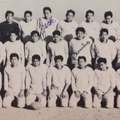Last month, I worked at Kinokuniya Bookstore’s booth at Anime Expo for the second year in a row. For two days, I stood in front of a display of posters, phone charms, and T-shirts featuring half-naked manga characters, both female and male. And for two days, I tried not to embarrass customers who walked shyly up to the register, asking if I could take a few life-size, cartoon-girl body-pillowcases out of their plastic packages, so they could see which one they wanted.
I have no interest in anime or manga, and other than a short, obligatory obsession with Pokemon cards in the late nineties, I never have. As an undergrad Japanese major, I had a few friends who loved cosplay and started Japanese 101 with decent accents despite coming from Rhode Island or Maine, thanks to hours spent watching One Piece. Thanks to those friends, I can’t judge non-Japanese anime nerds with one broad sweep anymore. But I used to do that. And my original discomfort with them, though softened, continues.
The first time I learned about “anime nerds,” the non-Japanese, (typically) white super-fans of anime and, by extension, all things Japanese, I was eleven. At the time, my family lived in Issaquah, Washington, a suburb of Seattle that was—like almost all the neighborhoods I’d lived in up to that point—predominantly white. At my middle school, throughout the year, my 6th-grade English and Social Studies class held presentations wherein a couple of students taught the class about some country’s culture. So, along with one other classmate, I signed up for Japan.
On the day of my presentation, my mom helped me pack a box full of props: hand-me-down silk kimono from my cousins in Osaka, kokeshi dolls, a Tupperware of onigiri to share with the class. I don’t remember what I said when I stood up at the whiteboard that day, but I do remember feeling proud. To me, being part-Japanese always felt important, even if inexplicably so, like taking care of some precious, ephemeral thing. In the end, I know, it boiled down to my mother. Being Japanese—studying hiragana on my own in a Doraemon notebook, shyly correcting my teacher’s pronunciation of “Sadako,” watching Miyazaki movies again and again—meant guarding her memories and my connection to her.
At the time, I was about fifteen years away from being able to put the feeling into those words, so I also had no words to explain how I felt when my blonde co-presenter stood up after me, presented magazines full of her favorite anime characters, then popped a video in the VCR. A J-rock group filled the screen, with their dramatic eyeliner and spiky hair; in Japan, my classmate told us knowingly, men are just more feminine than they are in the U.S.
Not having been to Japan since I was four, I couldn’t argue with her, but still I squirmed inside throughout her presentation, and I carried that feeling home with me until, after dinner, I told my mom what had happened. I think I hoped she would tell me what men really were like in Japan, to set the record straight, but instead she exploded.
“If you thought she was wrong, why didn’t you say something?” she shouted. “Why do you have to be so shy?” We stood in the kitchen yelling at each other until I ran off to my room in tears, horrified less by her anger and more by my own inability to step in and give my class truer information about Japan. Hours later, as I was falling asleep, my mom came to my room to apologize.
I still think of that fight as our worst ever, worse than any of the ones about boys or staying out late with friends—because those didn’t matter in the end; they were tied to age, rather than being tied to us, a first-generation mother and her American-born, half-white daughter, both trying to do justice to a culture in which she no longer lived, and I never had.
I’ve never been good at claiming authority over anything: a city, a subject, a culture. Despite years spent in a place, familial roots, or arguable birthright, I always feel like I’m a visitor, with only limited, conditional knowledge. So when I met anime nerds over the years, claiming knowledge of Japan despite looking at it through a narrow window, I felt angry and small.
Maybe if I looked more obviously Japanese it would have been a different story. Maybe then, more secure in my identity, I wouldn’t give a second thought to what others claimed to know. As is—still shrinking a little in my yukata at Obon, wondering if others see me as a white nerd playing dress-up—I try to fight my insecurity and assume the best in others, the way I hope they will assume the best in me.
Plenty of anime and manga fans would resent the sociological analysis, but in general non-Japanese fall in love with Japanese pop-culture because it provides a safe alternate universe where they can feel accepted in a way they don’t in their home societies. Yet were they to go to Japan, they would still be outside the mainstream—not just as gaijin but also as otaku.
I imagine that everyone lives between identities like this in some part of their life, hoping to be seen a little more clearly by others. I—who my mom once called her “American daughter with a Japanese heart”—embody this more literally than most. Anytime a well-meaning person tells me I don’t look much like her, I wish they’d open their eyes more, or know better than to vocalize the thought.
Who knows how the anime nerds identify under their costumes? After two Anime Expos, I see them with more compassion, even though I question their taste in body pillows.
* This article was originally published on The Rafu Shimpo on July 30, 2014.
© 2014 The Rafu Shimpo / Mia Nakaji Monnier






